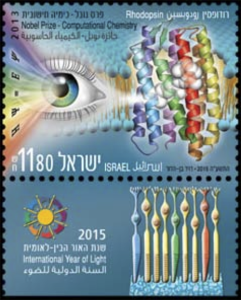This stamp will be issued February 10th.
[from Israel Post]
The International Year of Light 2015:
Nobel Prize 2013 – Computational Chemistry, Rhodopsin
 This stamp marks two events that have much in common.
This stamp marks two events that have much in common.
The first is the 2013 Nobel Prize in Chemistry that was jointly awarded to Martin Karplus (Harvard University), Michael Levitt (Stanford University) and Arieh Warshel (University of Southern California) for the development of multi-scale models for complex chemical systems. The prize recognized their revolutionary contributions during the years 1968–1976, which created the new field of computational molecular biophysics and provided new approaches and techniques for understanding complex biological molecules. Their approach changed the way we think about proteins and defined a new area of science, which has influenced and inspired many other fields.
The second event is the International Year of Light 2015, which was declared by the United Nations to celebrate the light sciences, light-based technologies and their importance to humankind.
The Israeli component of this Nobel Prize is significant. Michael Levitt, born in 1947 in Pretoria, South Africa, holds both British and Israeli citizenship. Arieh Warshel, born in 1940 in Kibbutz Sde-Nahum, Israel is a citizen of both the USA and Israel. Martin Karplus, born in Vienna in1930 to an Austrian Jewish family, fled with his family from the Nazi occupation to the USA in 1938. A substantial portion of the honored work was undertaken at the Weizmann Institute of Science when Warshel and Levitt were independent scientists and even earlier when both worked as students under the supervision of Shneior Lifson (1914-2001). Martin Karplus also conducted some of his research during a sabbatical year he spent working with the Lifson research group. It was a happy coincidence that the Nobel Prize committee recognized this group effort very close to what would have been Shneior Lifson’s 100th birthday.
One of the most impressive achievements of these Nobel laureates’ work is the molecular dynamics simulations of biological processes, such as enzymatic reactions, electron transfer reactions and ion transport in proteins. These simulations provide a computerized description of the actual events that occur in nature. One of the earliest and most significant examples of this strategy is the deciphering of the precise molecular events that occur during the process of vision. Arieh Warshel was the key researcher who described the role played by the protein Rhodopsin, which is the biological pigment in retina cells.
— Ehud Keinan
Professor of Chemistry at the Technion – Israel Institute of Technology
President of the Israel Chemical Society
Editor-in-Chief of the Israel Journal of Chemistry
Chairman of the Advisory Council, High School Chemistry Education, Ministry of Education
Description of the Stamp and the First Day Cover
The right side of the stamp features the protein Rhodopsin, which is a bundle of seven helices connected to each other by peptide loops. This protein, which is embedded within the cell membrane, binds retinal, a small light-sensitive molecule shown as a group of grey spheres that represent atoms. The left side of the stamp exhibits the Schrödinger equation, which is the most fundamental tool of quantum mechanics. Nobel Prize laureate Erwin Schrödinger formulated this equation in 1925 as a way to describe various states of atoms and molecules, opening the door for the science of theoretical and computational chemistry and physics.
The stamp tab features the logo of the International Year of Light as well as a schematic representation of the two major types of light-sensitive cells in the human retina: the rods (in yellow) and the cones (in blue, green and red). The rods are responsible for black-and-white vision and the cones are responsible for color vision. The human eye contains three types of cone cells, which discern red, green or blue light. All of the retinal cells translate the light stimulus to chemical changes and electrical impulses, which are transmitted to the vision centers in the brain via the optic nerves.
The First Day Cover shows two equations. The top row displays the Newton equation whereas the other three rows exhibit the Force Field U, which is the total potential energy of a molecule. Arieh Warshel and Shneior Lifson originally developed this equation in the late 1960’s to study the stability of small molecules. Levitt and Warshel used this equation to study large biomolecules. Karplus used it to study the dynamics of proteins by solving the Newton equation.



